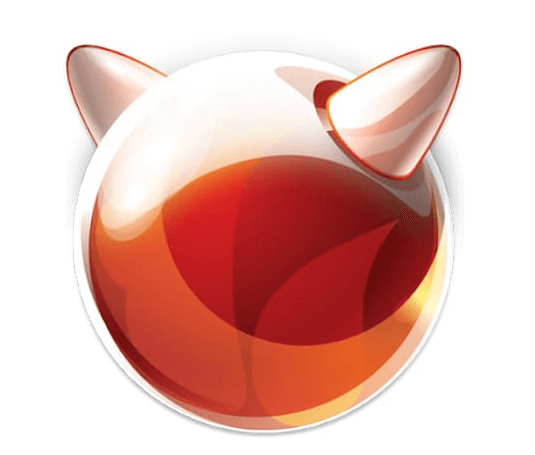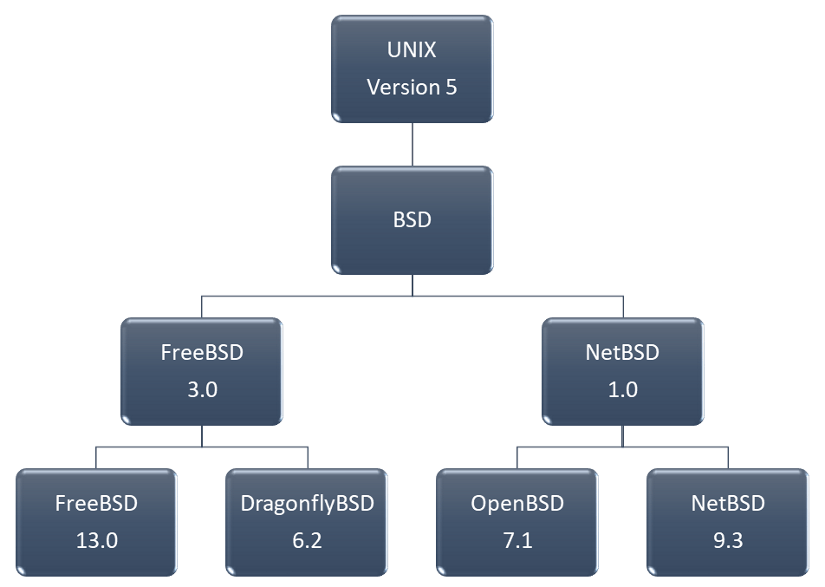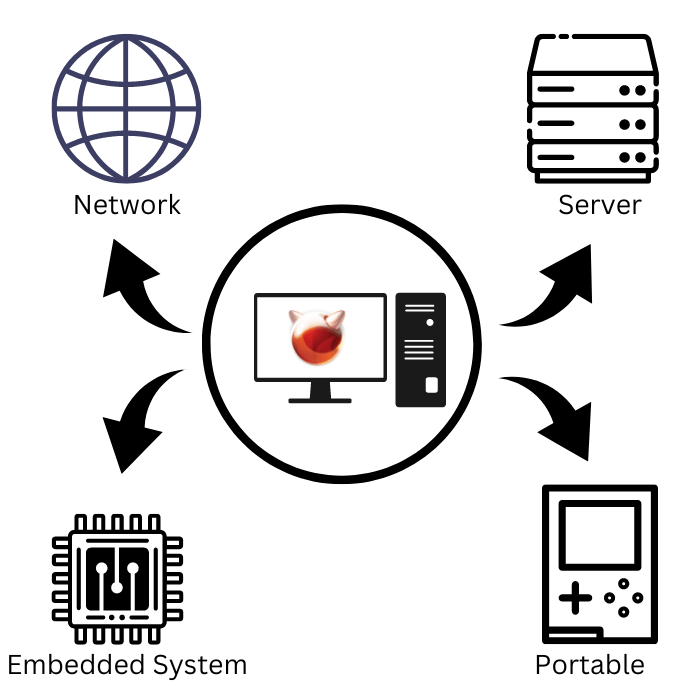FUNDAMENTALS A Complete Guide for Beginners

An operating system is an inseparable part of modern computers. Modern, light, and intuitive started with the development of UNIX. Then slowly, many operating systems started making their appearance. BSD was one of the first operating systems based on UNIX, then became an open-source platform for users. Even today, BSD extensively uses servers, networks, and embedded systems.
What is BSD UNIX?
BSD (Berkeley Software Distribution) is an operating system developed at the University of California at Berkeley in 1978. BSD is a UNIX- like operating system, which at first was quite different from UNIX. But then shared much of the source code from the original research UNIX operating system.
BSD has a monolithic kernel with all the system-level programs and files stored in kernel space. This kernel has the advantage of programs interacting with the hardware directly, using a common system resource.
Versions of BSD UNIX Operating System
Just like Linux, BSD has many versions available for open-source usage. Different versions have different objectives in mind. Here are some of the most used BSD systems.
OpenBSD
This version of BSD focuses on security. With an open-source concept and strict code reviews, the security and purity of the system are achieved. Organizations like banks, Governmental departments rely on this secured platform.
FreeBSD
This platform focuses on performance and ease. There are more users of this version than any other BSD version. Many web content providers use this platform for fast and reliable performance.
NetBSD
This is another platform that focuses on portability. Thus, this version can run on many types of devices, from palm-top devices to servers. Even NASA used this platform for space missions. NetBSD is especially useful for old non-intel devices.
DragonflyBSD
This BSD platform is performance and scalability centered. They can run on single-node systems to a large clustered system efficiently.
Advantages of BSD UNIX over Linux Operating System
There are different derivatives of the BSD operating systems, and depending on the versions, there are many advantages over widely used open-source operating systems like GNU/Linux distributions.
Here are 5 advantages BSD has over Linux.
- BSD runs really well with less powerful hardware. Because it was developed at a time when hardware had many limitations, on the other hand, Linux is more flexible but not that focused on old and slower hardware.
- BSD doesn’t necessarily require drivers for different hardware. You can run BSD by setting the kernel on the available hardware, and that’s it. But Linux requires drivers for various hardware. This advantage results in a more secure overall system for BSD, as Linux or other operating systems, must deal with many drivers that make the operating system less sustainable and less secure.
- BSD has continued for almost 44 years, and with all these years running, it has become very stable. The core of the system is so stable that there are close to no bugs in the system. However, Linux is modified worldwide, with many developers working on it. As a result, it is less stable, with occasional bugs here and there. But still, Linux is much better in condition compared to windows which had to deal with such a variety of hardware and drivers.
- You can run BSD on older hardware. It was built to work on old intel systems with UNIX experience. But Linux is limited to modern X86, ARM, and a handful of other hardware.
- BSD is a complete operating system where Linux is actually a kernel. To run Linux, you must install a distribution with many other tools like GNU tools, additional packages, third-party application documentation, etc.
Advantages of Linux over BSD UNIX Operating System
Just like its significant advantages, there are also some disadvantages to BSD. Here are 5 disadvantages of BSD compared to Linux.
- Linux has more application support, both built-in and third-party. Much commercial software is not available in BSD, but there is enormous software support worldwide in Linux.
- Linux has GNU General Public License, but BSD has its own license. But BSD also has some open-source platforms that have significant use in specific fields.
- Linux has quick support for any type of application, package, or bug. But in BSD, there’s a conservative approach to software support. So the software support may not be as quick, but in return, there is greater stability and fewer bugs than other operating systems.
- BSD does not have a graphical user interface officially. Yes, some distros available have a graphical desktop interface, but many of them get discontinued due to less usage. On the other hand, Linux has many distros that provide great GUI out of the box, which can be used as a daily driver.
- Resource on BSD is comparatively smaller than Linux. So, there’s a steep learning curve for BSD.
Usage of BSD UNIX Operating System
The most prominent use of BSD is not in everyday use for consumers but in commercial servers, data centers, and networks. Here are some of the sectors that have comprehensive use of BSD.
Servers
BSD is a stable operating system focusing on efficient server applications. BSD even has dedicated applications and packages for easy configuration and usage. There are used in FTP servers, mail servers, DNS servers, and routers.
Networking
BSD has extensive use in network systems and protocols. It supports a wide range of networks like IPv6, IPsec, and SCTP. It even supports many legacy protocols and CARP (Common Address Redundancy Protocols). CARP has many advantages but mainly helps in multiple nodes for a common set of IP addresses so that crashing in only one node does not disable the whole server, and another node can take the lead.
Portability
BSD operating system has much portability as it has excellent support for older devices, and driver support is not an issue as it can be configured with other hardware. The support for different hardware is divided into many different tires. Tire 1 architecture has complete support, whereas tier 4 architecture has no support at all.
Embedded System
BSD was developed for much different hardware and supported hardware from intel, PowerPC, MIPS, and ARM of much older versions.
Conclusion
BSD is a UNIX-based operating system that has many open-source versions. However, they are not actually for everyday use by consumers. It has had support for almost 44 years and continues to be used by servers and networks. BSD’s security, stability, and absence of bugs make it an excellent choice for commercial and embedded system usage.
People Also Ask
Is BSD a Unix-like OS?
Yes, BSD (Berkeley Software Distribution) is a Unix–like operating system. The BSD operating system has its roots in the Unix operating system developed at the University of California, Berkeley. The original BSD releases were based on the Unix source code from AT&T, but over time, BSD evolved independently and included significant enhancements and modifications.
While there are various Unix-like operating systems, including Linux, AIX, and HP-UX, BSD is considered one of the major branches of Unix. FreeBSD, NetBSD, and OpenBSD are notable BSD variants, each with its own characteristics and goals. These BSD systems adhere to Unix principles and design philosophies, providing a Unix-like environment with features and commands similar to those found in traditional Unix systems.
Which is better Linux or BSD?
The choice between Linux and BSD depends on individual preferences and specific use cases. Linux offers broader hardware and software support with a diverse range of distributions, making it a common choice for compatibility and versatility. BSD, notably FreeBSD, is praised for its stability, performance, and consistent system design, making it well-suited for server and networking infrastructure.
Linux has a larger and more diverse community, providing extensive documentation and support forums, while BSD communities are often smaller but tightly knit. The licensing philosophy, with Linux commonly using the GPL and BSD using a more permissive license, may also influence the decision based on individual or organizational preferences. Ultimately, the “better” choice is subjective and should be based on the priorities and goals of you or the organization.
Which BSD is closest to Unix?
Among the BSD (Berkeley Software Distribution) operating systems, FreeBSD is often considered the one that stays closest to the traditional UNIX design principles. FreeBSD aims to provide a system that is true to the original UNIX philosophy and design, as outlined by the Berkeley Software Distribution.
FreeBSD shares historical roots with UNIX, stemming from the original BSD releases developed at the University of California, Berkeley. It has continued to evolve while maintaining a focus on stability, performance, and adherence to UNIX-like principles.
While FreeBSD is often regarded as the BSD system closest to traditional UNIX, it’s essential to note that all the major BSD variants—FreeBSD, OpenBSD, and NetBSD—have their unique features, strengths, and use cases. The specific goals and priorities of each BSD project may lead to differences in focus, security, and additional features. Users often choose the BSD variant that aligns best with their specific requirements and preferences.
Is BSD monolithic?
Yes. The BSD operating systems, such as FreeBSD, NetBSD, and OpenBSD, are generally considered to be monolithic kernels. A monolithic kernel is an operating system kernel that executes all operating system code in the same address space, as opposed to a microkernel, where some components run in user space.
In a monolithic kernel architecture, most of the core operating system functionality, including device drivers and file systems, is implemented as a single, large program running in kernel mode. The BSD kernels follow this design philosophy, and they provide a tightly integrated and efficient environment for system calls and other kernel-level operations.
However, the distinction between monolithic and microkernel architectures is not always black and white, and some operating systems may exhibit hybrid characteristics. However, the BSD family, in general, is commonly categorized as using a monolithic kernel architecture.
Similar Readings





